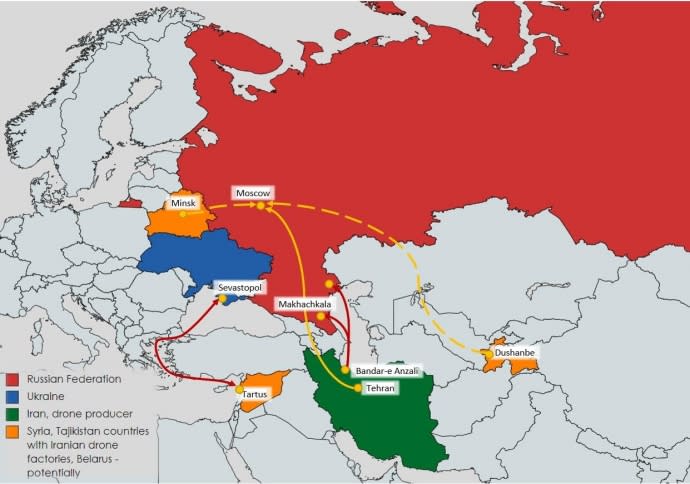Iran has been supplying Russia with drones in two ways: by air and by sea.
Source: National Resistance Center
The Center states that Iran actively supplies the Russian Federation with the following models of UAVs: Mohajer-6, Arash-1 and Arash-2, Shahed-131 and Shahed-136.
There are two ways of transporting drones from the manufacturer to their destinations: air and sea.
The following companies deliver drones and send instructors by air:
Iran Air (Iranian state airline controlled by the local Ministry of Infrastructure);
Mahan Air (the founder is the “Nonprofit Institute of Molal Movakhedin”);
Pouya Air (part of the Islamic Revolutionary Guard Corps (IRGC), the military branch of the executive branch of the Islamic Republic of Iran);
Saha Airlines (Part of the Air Force of Iran).
The airlines in question are the three state-owned and one supposedly private. At the same time, state-owned companies are subordinate to the military and political leadership, which, despite public statements, provides full support for the Russian invasion of Ukraine.
As for the private airline, it is private only relatively. The founder of the commercial institute is Hossein Marashi (former vice president of Iran). Since the end of 2011, the company has been on the US sanctions list for providing material and technical support to the IRGC, which in fact controls the airline and uses it for its own purposes.
The National Resistance Center notes that only Pouya Air conducted five cargo flights on the Tehran-Moscow route from 12 to 18 October. Most of the fleet of cargo planes are Russian IL-76s.
Iran also uses the sea route through the Caspian Sea to transport drones. According to the documents, the Iranians transport spare parts for civil aviation using the port of Bandar Anzali. The destination is either Astrakhan or Makhachkala.
Transportation is carried out by vessels of the Iranian Industrial Company (controlled by IRGC). In particular, in early November, 200 units of disassembled drones are expected to arrive in Astrakhan by sea.
The Russians also actively export Ukrainian grain by water to Syria, along the Sevastopol-Tartus route. On the way back, Iranian-made drones and their components from the Syrian factory may be transported in containers, although there is no confirmation of this at the moment.
In particular, in Syria, the Russians can take Iranian-made surface-to-surface missiles Zolfaghar, which are based in Syria, which also has a factory for the production of kamikaze drones.
In general, Iran is currently diversifying its drone production in other countries. In addition to Syria, the plant has been operating in Tajikistan since May. There are also risks of setting up a node assembly in Belarus, because the local 558th Aircraft Repair Plant, in cooperation with the Kvand IS company, speeded up the creation of its own “kamikaze drones”, which can be a cover for the use of Iranian-made developments, the National Resistance Center notes.
As preliminary data states, Iran can produce up to 150 drones per month. They get the parts from China to bypass sanctions, which allows them not to worry about their shortage. Taking into account the significant request of the Russian Federation for UAVs, all the specified production sites and delivery routes will definitely be involved, the National Resistance Center states.
Journalists fight on their own frontline. Support Ukrainska Pravda or become our patron!





